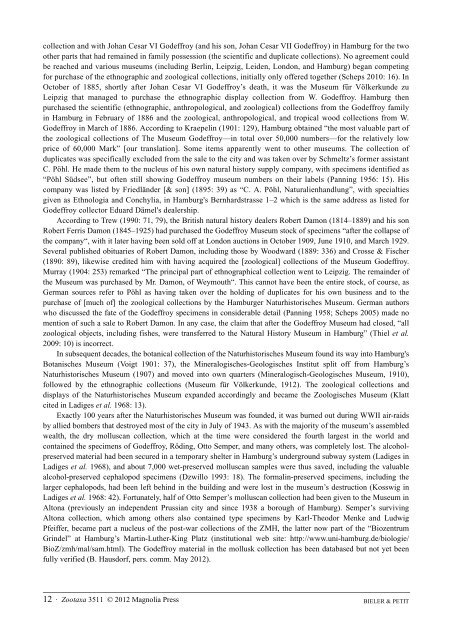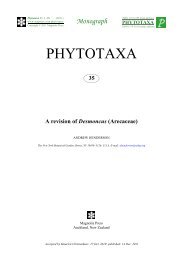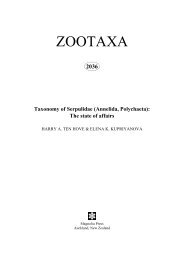You also want an ePaper? Increase the reach of your titles
YUMPU automatically turns print PDFs into web optimized ePapers that Google loves.
collection and with Johan Cesar VI Godeffroy (and his son, Johan Cesar VII Godeffroy) in Hamburg for the two<br />
other parts that had remained in family possession (the scientific and duplicate collections). No agreement could<br />
be reached and various museums (including Berlin, Leipzig, Leiden, London, and Hamburg) began competing<br />
for purchase of the ethnographic and zoological collections, initially only offered together (Scheps 2010: 16). In<br />
October of 1885, shortly after Johan Cesar VI Godeffroy’s death, it was the Museum für Völkerkunde zu<br />
Leipzig that managed to purchase the ethnographic display collection from W. Godeffroy. Hamburg then<br />
purchased the scientific (ethnographic, anthropological, and zoological) collections from the Godeffroy family<br />
in Hamburg in February of 1886 and the zoological, anthropological, and tropical wood collections from W.<br />
Godeffroy in March of 1886. According to Kraepelin (1901: 129), Hamburg obtained “the most valuable part of<br />
the zoological collections of The Museum Godeffroy—in total over 50,000 numbers—for the relatively low<br />
price of 60,000 Mark” [our translation]. Some items apparently went to other museums. The collection of<br />
duplicates was specifically excluded from the sale to the city and was taken over by Schmeltz’s former assistant<br />
C. Pöhl. He made them to the nucleus of his own natural history supply company, with specimens identified as<br />
“Pöhl Südsee”, but often still showing Godeffroy museum numbers on their labels (Panning 1956: 15). His<br />
company was listed by Friedländer [& son] (1895: 39) as “C. A. Pöhl, Naturalienhandlung”, with specialties<br />
given as Ethnologia and Conchylia, in Hamburg's Bernhardstrasse 1–2 which is the same address as listed for<br />
Godeffroy collector Eduard Dämel's dealership.<br />
According to Trew (1990: 71, 79), the British natural history dealers Robert Damon (1814–1889) and his son<br />
Robert Ferris Damon (1845–1925) had purchased the Godeffroy Museum stock of specimens “after the collapse of<br />
the company“, with it later having been sold off at London auctions in October 1909, June 1910, and March 1929.<br />
Several published obituaries of Robert Damon, including those by Woodward (1889: 336) and Crosse & Fischer<br />
(1890: 89), likewise credited him with having acquired the [zoological] collections of the Museum Godeffroy.<br />
Murray (1904: 253) remarked “The principal part of ethnographical collection went to Leipzig. The remainder of<br />
the Museum was purchased by Mr. Damon, of Weymouth“. This cannot have been the entire stock, of course, as<br />
German sources refer to Pöhl as having taken over the holding of duplicates for his own business and to the<br />
purchase of [much of] the zoological collections by the Hamburger Naturhistorisches Museum. German authors<br />
who discussed the fate of the Godeffroy specimens in considerable detail (Panning 1958; Scheps 2005) made no<br />
mention of such a sale to Robert Damon. In any case, the claim that after the Godeffroy Museum had closed, “all<br />
zoological objects, including fishes, were transferred to the Natural History Museum in Hamburg” (Thiel et al.<br />
2009: 10) is incorrect.<br />
In subsequent decades, the botanical collection of the Naturhistorisches Museum found its way into Hamburg's<br />
Botanisches Museum (Voigt 1901: 37), the Mineralogisches-Geologisches Institut split off from Hamburg’s<br />
Naturhistorisches Museum (1907) and moved into own quarters (Mineralogisch-Geologisches Museum, 1910),<br />
followed by the ethnographic collections (Museum für Völkerkunde, 1912). The zoological collections and<br />
displays of the Naturhistorisches Museum expanded accordingly and became the Zoologisches Museum (Klatt<br />
cited in Ladiges et al. 1968: 13).<br />
Exactly 100 years after the Naturhistorisches Museum was founded, it was burned out during WWII air-raids<br />
by allied bombers that destroyed most of the city in July of 1943. As with the majority of the museum’s assembled<br />
wealth, the dry molluscan collection, which at the time were considered the fourth largest in the world and<br />
contained the specimens of Godeffroy, Röding, Otto Semper, and many others, was completely lost. The alcoholpreserved<br />
material had been secured in a temporary shelter in Hamburg’s underground subway system (Ladiges in<br />
Ladiges et al. 1968), and about 7,000 wet-preserved molluscan samples were thus saved, including the valuable<br />
alcohol-preserved cephalopod specimens (Dzwillo 1993: 18). The formalin-preserved specimens, including the<br />
larger cephalopods, had been left behind in the building and were lost in the museum’s destruction (Kosswig in<br />
Ladiges et al. 1968: 42). Fortunately, half of Otto Semper’s molluscan collection had been given to the Museum in<br />
Altona (previously an independent Prussian city and since 1938 a borough of Hamburg). Semper’s surviving<br />
Altona collection, which among others also contained type specimens by Karl-Theodor Menke and Ludwig<br />
Pfeiffer, became part a nucleus of the post-war collections of the ZMH, the latter now part of the “Biozentrum<br />
Grindel” at Hamburg’s Martin-Luther-King Platz (institutional web site: http://www.uni-hamburg.de/biologie/<br />
BioZ/zmh/mal/sam.html). The Godeffroy material in the mollusk collection has been databased but not yet been<br />
fully verified (B. Hausdorf, pers. comm. May 2012).<br />
12 · Zootaxa 3511 © 2012 <strong>Magnolia</strong> <strong>Press</strong><br />
BIELER & PETIT
















